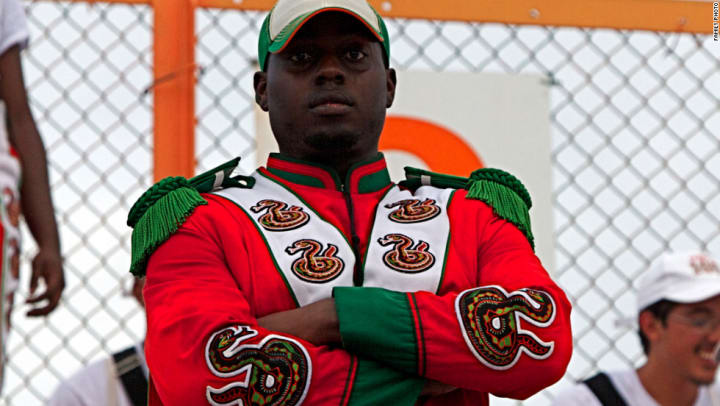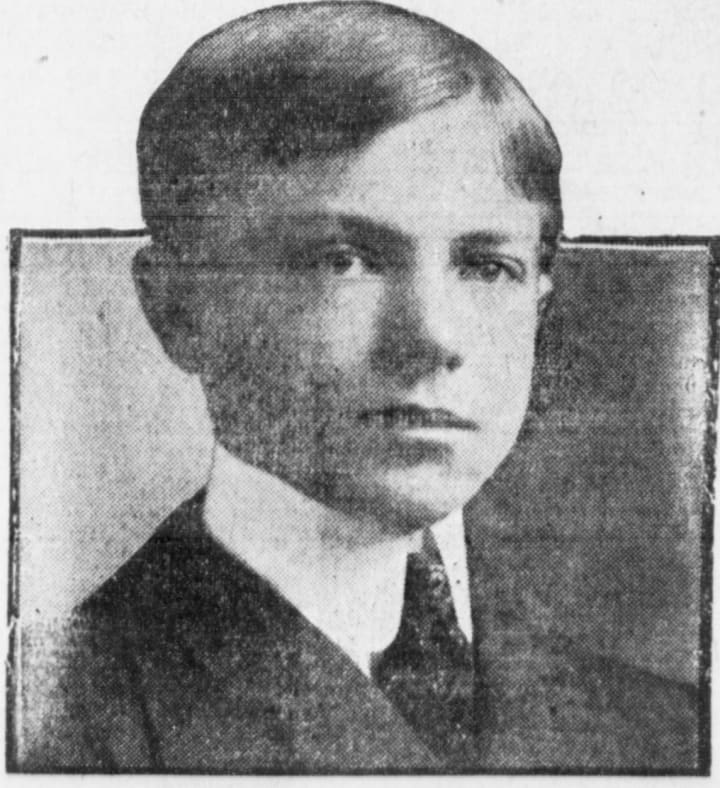10 Hazing Deaths That Shocked College Campuses
Hazing deaths are what happen with tradition gets warped into a criminal act—and these grisly stories might make you think twice about pledging.

How far would you go to make friends? Would you join a school organization? Would you pay monthly dues so you could hang out with them? Would you guzzle drinks, get beat up, or let your "friends" drop you off in the middle of the woods?
If you're in a fraternity or a sorority, then the answer to all of those things is a resounding yes. Every year, thousands of young men and women decide that they will go the extra mile to get the companionship and connections they want.
Back when I was in college, I remember hearing that there were some things I should know before joining Greek life. One of these was that I would have to pay monthly dues if I chose to "go Greek."
Something about that didn't strike me right; why would you need to pay people to be their friends? As a result, I didn't join. Later on, I also heard that they did their own amount of hazing—and I realized that I probably dodged a bullet.
Hazing, if you didn't know, is the illegal practice of forcing people to do embarrassing, dangerous, or violent things in order to be accepted into an official organisation. It may sound like it's really no big deal, but the truth is, hazing is very dangerous.
Over the decades, there have been dozens of hazing deaths swept under the rug. These are some of the more tragic stories of people who died trying to fit in with the wrong group of kids, proving that sometimes college is not the best option.
Chung Deng was a proud hopeful pledge of Pi Delta Psi—and unlike other pledges, had managed to make it to the final stage. The final initiation rite was running something that they called "the Glass Ceiling."
The Glass Ceiling required each pledge to carry a backpack filled with 20 pounds of sand across a room while being beaten by current fraternity members. He was expected to cross the room while blindfolded.
Here's where toxic masculinity went haywire.
As Deng shoved his way across the room, he kicked a fraternity member. The fratboys grew enraged. All of them reacted by kicking the hits up a notch. One charged into him, running with his head lowered until he hit Deng in the stomach.
Deng fell to his knees. Another pushed him to the ground after the wind was knocked out of him. They didn't stop until Deng was unconscious, and he was laid down.
Soon after, fraternity members began to realize something wasn't right with Deng. They called the fraternity's president to figure out what to do. He told the boys to expunge all records involving Deng, and a coverup was initiated.
Three hours after he collapsed, the guys brought Deng to the hospital. He was covered in bruises and suffered significant brain injuries. He was pronounced brain dead, and his parents took him off life support.
Over 30 people were charged in his death, making it one of the most notorious hazing deaths in recent years. The charges ranged from hazing, to assault, to conspiracy, to manslaughter, to voluntary homicide. At least three men were sentenced to 36 months in prison.
Mortimer M. Leggett remains one of the first hazing deaths in history, but that doesn't mean his was any less shocking. As the son of a Civil War general, Leggett was accepted to Cornell in 1873.
Back in those days, hazing rituals were pretty hardcore and totally legal. If you didn't join a fraternity or a sorority, you were in big trouble. So, Leggett really didn't have a choice. He pledged Kappa Alpha.
For his hazing, members took him out to the woods and blindfolded him. From there, he was supposed to find his own way back to the fraternity's house in Ithaca, where he would be greeted as a new member.
He and three other young men lined up and were told to start walking. The Cornell Daily Sun explained what happened next best:
"What they did not realize was that at the bottom of the slope was not a road, but a 37 foot cliff. There was no warning as they plunged over. Mort died on the hard-packed rock-like clay at the foot of the cliff. The other two boys were badly hurt."
Robert Champion

Believe it or not, hazing deaths don't always happen in fraternities or sororities. They can happen with school sports teams and marching bands as well. Such was the case with Robert Champion, one of the most promising drum majors at Florida A&M University.
FAMU's marching band is known for its hazing process, and sadly, this time around, it was hazing with a side of racism. Champion had already started to make enemies because of his strict "by the books" behavior—and when the initiation ritual happened, band members decided it was payback time.
The initiation required students to cross the length of a bus while band members hit them. If they vomited or collapsed, the band members would have to do it again. Before Champion even began, multiple band members already suffered serious beatings and had to be excused for vomiting.
"Send the n____ through!" shouted one of the band mates.
He began, and almost immediately was pulled down into a seat. He was cornered and couldn't get up. One student supported himself with a bus seat, then started jumping on Champion's torso for 15 seconds.
Students only grew concerned when he remained unresponsive while his eyes were open. They dragged him out of the bus and tried to perform CPR, but it was too late. By the time the students called the police, he had died of blunt trauma.
Robert Champion's death was ruled a homicide, with the resulting investigation leading to the charge of 15 different people. The president of "Bus C," his bus, was given 77 months in prison.
Chico University's Chi Tau fraternity had a seriously nasty reputation for its hazing process. The week of initiation was known as "Hell Week," and it earned its moniker pretty well.
Matthew Carrington was one of the young boys who wanted to join Chi Tau as a way to make friends and get business connections. The hazing process, though, would end up killing him.
The last hours of Carrington's life were spent doing calisthenics in a freezing cold basement while members dumped freezing cold water on him and blew fans on him. After five hours, he was refused entry to the bathroom. He pissed himself.
Finally, after the fratboys made him undergo hours upon hours of exercise in freezing cold temperatures, they forced him to drink a gallon of water. This triggered a seizure, and fraternity members delayed calling the police.
He died of hypothermia and water intoxication. Chi Tau members who were involved in his death were sentenced to prison, and the chapter was thankfully shuttered.
Not all hazing deaths happen while you're being hazed. In the case of Benjamin Klein, it can happen as a form of retaliation shortly after the hazing has ended.
Benjamin Klein was a hopeful at Zeta Beta Tau at Alfred University, but after going through the organization's hazing practices, he decided to out the fraternity's illegal behavior. ZBT members didn't like that very much.
To retaliate (or give a preemptive strike), they tied him up, beat him, and ran the shower on him while his mouth was duct taped shut. He had to agree not to leave the frat house to be set free.
Three days later, they found his body in a creek. The death was ruled a suicide, but his body was covered in bruises. That doesn't mean frat brothers walked away free, though.
Multiple brothers pled guilty to assaulting Klein before he "killed himself." Alfred University also shuttered all fraternities on its campus after Klein's death, citing safety concerns.
Stuart Pierson

In 1905, hazing was legal—but that doesn't mean that there weren't major scandals tied to the practice. One of the worst happened to a young guy named Stuart Pierson, who was trying out for Delta Kappa Epsilon at Kenyan College.
As part of his initiation he was tied down to a railroad track for hours. This sounds like it'd be fine, but an unscheduled train decided to barrel through.
His frat brothers claimed that Pierson "fell asleep on the train tracks," but the coroner found evidence otherwise. His wrists and ankles (or what remained of them) were dislocated. This meant that he had struggled to try to free himself as he saw the train coming.
Imagine being able to see a train approaching you, knowing it will kill you, and being unable to move out of the way.
If you're planning to live off campus with others involved in Greek Life, consider James Lenaghan. One of the leading causes of hazing deaths is alcohol poisoning, and it's understandable why. Greek life and heavy drinking just go hand in hand—even though most members are under the legal drinking age.
James Lenaghan may have one of the most bizarre deaths on record. To join the Zeta Chis of the American International College, he had to undergo the "Spaghetti Ritual."
The Spaghetti Ritual involved pledged eating bowl after bowl of spaghetti and drinking red wine. They'd throw up, then continue to eat and drink. At one point, Lenaghan started to beg brothers to tell him to stop.
Hint: they didn't.
He eventually lost control of his bowels while sitting at the table. Fraternity members finally decided that was enough, and dragged him into the bathtub so he could "sleep it off."
He never woke up from that sleep. When coroners examined his body, they found that his BAC was .48—a lethal dose of alcohol by any standard. He never had a chance.
SAE, also known as Sigma Alpha Epsilon, currently has a longstanding reputation for hazing-related problems across the country. There was that fairly recent scandal where pledge members were caught on tape singing a racist song (above) and there were also plenty of hazing deaths linked to them.
One such death was Carson Starkey, who was part of Cal Poly's SAE chapter. He was hazed as part of "Brown Bag" night, which is a hazing ritual that involves forcing pledges to drink whatever is handed to them in a brown bag.
In Starkey's case, it was Everclear, rum, and Sparks. He was expected to drink it all within a matter of minutes. He did—and then he passed out almost instantly. Fraternity brothers didn't call the police.
They left him on a frat house mattress where alcohol poisoning claimed his life. His BAC registered a .40 when he died, which is five times the legal driving limit.
Another casualty linked to SAE was a young man by the name of George Desdunes. This SAE chapter belonged to Cornell, and was known for its "reverse hazing" process.
The sophomore was duct taped and tied up with zipties by freshmen. Then, he was interrogated with obscure trivia questions about the fraternity.
Every time he answered a question incorrectly, he was fed a cocktail of vodka, Pixy Stix, dish soap, hot sauce, and chocolate powder. After multiple incorrect questions, George started to vomit.
The fraternity left him on a couch, hoping he'd recover. He choked on his vomit while passed out, and members found him dead in the morning. Four different fraternity members were charged in his death.
Tim Piazza's death is one of the most recent hazing deaths on this list, and remains a warning tale for those who want to join Greek life. Piazza pledged Penn State's Beta Theta Pi fraternity—and it was the worst mistake of his life.
Piazza was expected to run "the Gauntlet," a ritual which involved drinking from a bag of wine, a bottle of beer, and then a bottle of vodka. This didn't work well with Piazza's antidepressants, which exacerbated the effects of alcohol.
In his drunken stupor, Piazza fell down the stairs and was knocked unconscious. A bruise started to form on his side, and one of the brothers asked someone to get Piazza medical attention. He was ignored, and Piazza was placed on the couch.
At one point, Piazza regained some consciousness, then rolled off the couch. He was seen on surveillance, gripping his abdomen. The fraternity brothers threw him back on the couch—and then began to get worried when he became unresponsive.
They started to punch him, throw beer on him, and slap him. No dice. He eventually regained consciousness, tried to stand, then collapsed. This continued several times, until he finally collapsed and hit his head on the stairs.
Eventually, a brother found him on the floor, breathing rapidly as his body decreased in temperature. The members debated for about 40 minutes, then decided that he needed medical attention. They wiped the blood from his mouth and tried to change his clothes, but his body was too stiff.
Doctors found that his brain swelled up to the point that half his skull had to be removed. He had a ruptured spleen and was deemed "non-recoverable." He died, and multiple people were charged for his death.
Charges ranged from hazing to involuntary manslaughter.
About the Creator
Iggy Paulsen
Iggy Paulsen is a fan of anything and everything wholesome. He loves his two dogs, hiking in the woods, traveling to Aruba, building DIY projects that better humanity, and listening to motivational speakers. He hopes to eventually become a motivational speaker himself.






Comments
There are no comments for this story
Be the first to respond and start the conversation.